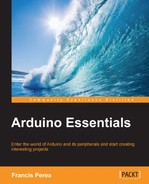I'm sure you have got the point regarding interrupts with all the things we have seen in this chapter.
We have met and understood what an interrupt is and how the CPU attends to it by running an ISR, and we have even learned about their special characteristics and restrictions and that we should keep them as few as possible.
On the programming side, the only thing necessary to work with interrupts is to correctly attach the ISR with a call to the attachInterrupt() function.
From the point of view of hardware, we have assembled an encoder that has been attached to a spinning motor to account for its revolutions.
Finally, we have the code. We have seen a relatively long sketch, which is a sign that we are beginning to master the platform, are able to deal with a bigger number of peripherals, and that our projects require more complex software every time we have to deal with these peripherals and to accomplish all the other necessary tasks to meet what is specified in the project specifications.
In the next and final chapter, we will see another real-case application for Arduino, controlling a greenhouse this time.
